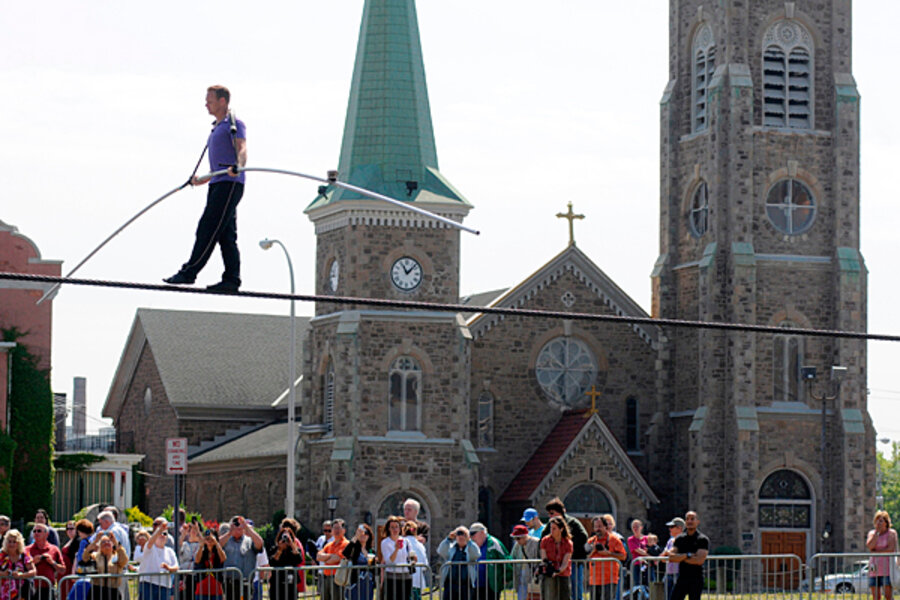Wallenda, a tightrope, and the Grand Canyon: why stunts are new TV staple
Loading...
Live television and a death-defying stunt: It's a marriage made in ratings paradise – and a pairing that is becoming more prevalent as networks seek must-see live TV to compete with DVRs that allow viewers to watch later ... and skip the commercials.
When Nik Wallenda, a daredevil specializing in high-wire outdoor stunts, attempts to cross a remote spot in the Grand Canyon on June 23, The Discovery Channel will televise the event live. The cable network outbid competitors to pay Mr. Wallenda an undisclosed sum for exclusive rights to the stunt.
Already, Mr. Wallenda is marketing the Grand Canyon crossing for its dramatic highlights, framing it as a “lifelong dream” to pay honor to his great-grandfather, who died during a similar tightrope walk in 1978. Moreover, he says he will perform the 1,500-foot-high walk without a safety harness.
Discovery announced the stunt Monday, calling it a “nail-biting, play-by-play live event” and “the most daring and captivating live events in history.”
“The stakes don’t get much higher than this,” Wallenda said in a press release. “The only thing that stands between me and the bottom of the canyon is a two-inch-thick wire. I’m looking forward to showing the audience a view of the canyon they’ve never seen before.”
The event confirms a fast-growing trend among networks, which are increasingly desperate to compete against the DVR. That time-bending technology allows viewers to zoom past commercials, thereby diminishing the value of the program’s content for advertisers who pay mighty sums to get their brands before every eyeball they can.
Watching television shows via DVR, video on demand, or online streaming services versus watching television in real time when the shows are first broadcast creates competing values for the programs, according to the Nielsen company, which publishes weekly ratings. The average US viewer watches more than 32 hours of live television each week, but also spends at least 12 hours watching television via DVR, online, and other methods outside their set-top television, Nielsen reports.
That technology makes some shows successful long after they are broadcast. For example, during the last week in January ABC's “Modern Family” ranked No. 12, with 10.8 million viewers who watched the program in real time. However, that number jumped to 15.9 million after people watched the episode via DVR and online within seven days after the program was broadcast, which made it the No. 3 most popular show on television, according to the Associated Press.
The multidimensional ways in which people now watch television is forcing Nielsen to recalculate how it reports ratings. In September, the company will start reporting viewership through broadband devices such as gaming consoles, which currently are not counted.
All this means that television networks feel the need to increase the value of their live programming, and that blockbuster live events they can promote weeks in advance fit that bill well. Awards shows such as the Academy Awards and sporting events such as the Super Bowl are staples of this genre, and daredevil events, live fashion shows, and after-party red carpet events are natural contenders.
Wallenda brought 13 million viewers to ABC last June for his tightrope walk across Niagara Falls, lifting the network to a first-place finish that week. Months later, Discovery jumped into the fray, broadcasting a live space jump by Felix Baumgartner, which earned it 7.6 million total viewers, a network record.
Nonsporting events are becoming more desirable for advertisers, as they allow companies to promote their brands to a fixed audience. Advertisers spent $444 million on live nonsporting events in 2012, a 22 percent increase from five years ago, according to Kantar Media, a media analysis firm based in New York City.
“There’s a real hunger for that [live] experience, which in some ways has been further fueled by the growth of DVR. In today’s world of social media, live TV starts the conversation that lives on Twitter and other social networks,” Suzanne Kolb, E! president, told the Hollywood Reporter this month.
The Grand Canyon walk will be the highest Wallenda has ever attempted, Discovery says. He will walk above the Little Colorado River, a section of the park that is controlled and operated by the Navajo Nation, which says it, too, sees opportunity in the live broadcast.
“We use our land and all elements of life as teaching tools for our youth and visitors from afar,” says Helen Webster, park manager of Navajo Parks and Recreation. “We welcome this special event, and the community is excited to be a part of it.”






